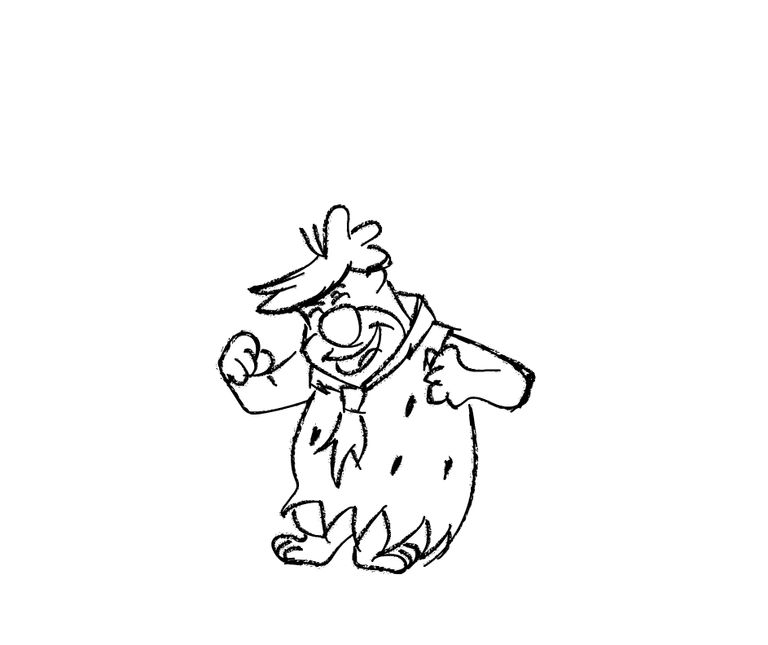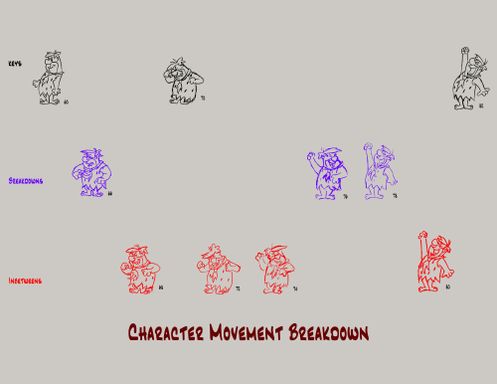Animation & Comic Strip Art c 2024 Rudy Agresta
Animation & Comic Strip Art c 2024 Rudy Agresta
The Evolution of a Scene
This ruff animation for Fred Flintstone (c Hanna Barbera Prod) involves 3 basic steps. FIRST, creating key drawings in poses that best depict the acting you are after. SECOND, timing the key drawings to obtain a convincing action. THIRD, adding breakdown and inbetween drawings to smooth out the action as well as adding secondary actions like eye blinks, all to be projected at 24 frames per second.

KEY DRAWINGS
Untimed and evenly spaced
KEY DRAWINGS
TIMED
Key drawings now timed
KEYS WITH BREAKDOWN & INBETWEENS
Additional drawings added to the keys to smooth out the action
CHARACTER MOVEMENT BREAKDOWN FOR
POSE-TO-POSE ANIMATION
In defining a movement with drawings for animation, an animator will make what are called EXTREME drawings. Extremes basically show the beginning and end poses of a movement. The extremes, along with any other drawings that define the overall arc of the movement become what are called KEY drawings. These key drawings are then timed (assigned frame numbers) to better define the action occurring over time. The numbers to the right of the character poses refer to the frame number each occupies in sequence. Animation is projected at 24 frames per second. With the exception of holding a particular drawing for several frames for impact, most animation is done on what is called 2s, meaning each animation drawing is held for 2 frames. This means that an animator needs draw only 12 drawings for each second of animation. Next come the BREAKDOWN drawings. The breakdown drawings are basically inbetween drawings, but they define the path the rest of the drawings need to take to precisely define the animator's vision of how the movement needs to look. I define breakdowns as the "how-to" drawings, meaning, how I want to get from one key drawing to the next. These breakdowns define the movement in a way for the next stage, producing the INBETWEEN drawings. The inbetweens are the necessary element to make the overall movement look smooth once the animation is projected at 24 frames per second. When working with assistants, the animator usually does the extreme/key drawings and times them. He/she may produce all, or at least the most necessary breakdowns. The rest of the drawings are left to the assistant, commonly known as the "inbetweener."
This method is referred to as Pose-To-Pose animation; making key poses, time them, and fill in with breakdowns and inbetweens.
Another method is the Straight Ahead method. Here, the animator starts with drawing number 1 and keeps drawing until fiinshed, timing the action and adding an additional inbetween or two if necessary. This method works best for complicated or fast and frenzied actions where key posing may be difficult. Key posing is best for acting and for dialog scenes.
Most of the time, I employ a combination of both methods. Often my KEYS are thumbnail poses which give me an overall idea of where I want to go. From that I will animate straight ahead using the thumbnails as a guide, timing the action and adding additional drawings as needed once the scene is completed and checked. An example of the Straight Ahead method will be shown on another animation page.
© Copyright. All rights reserved.
We need your consent to load the translations
We use a third-party service to translate the website content that may collect data about your activity. Please review the details and accept the service to view the translations.



